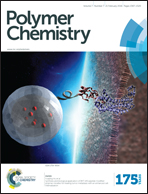Synthesis of a [60]fullerene-end-capped polyacetylene derivative – a “rod-sphere” molecule from a “coil-sphere” precursor†
Abstract
Herein, we report the synthesis of a hybrid material composed of a head-to-head substituted polyacetylene end-capped with [60]fullerene through anionic polymerization. The synthesis was carried out in three successive steps: anionic polymerization of 2,3-diphenyl-1,3-butadiene, anionic addition of the resulting living chains towards C60, and dehydrogenation of the polymer segment in the presence of 2,3-dichloro-5,6-dicyano-1,4-benzoquinone (DDQ). Since the precursor polymer is a coil-like polybutadiene derivative and the dehydrogenated polymer is a rod-like conjugated segment, the molecular hybrids underwent a change from a “coil-sphere” to “rod-sphere” conformation before and after dehydrogenation. The structure and properties of the molecular hybrids were investigated via1H NMR, FTIR, GPC, FLS, UV and TGA. The self-assembly behaviors of both molecular hybrids in THF were studied using DLS and TEM. Moreover, we also observed an obvious optical limiting property of the hybrid product, which indicates that it may potentially be utilized as a functional opto-electronic material.
![Graphical abstract: Synthesis of a [60]fullerene-end-capped polyacetylene derivative – a “rod-sphere” molecule from a “coil-sphere” precursor](/en/Image/Get?imageInfo.ImageType=GA&imageInfo.ImageIdentifier.ManuscriptID=C5PY01674F&imageInfo.ImageIdentifier.Year=2016)

 Please wait while we load your content...
Please wait while we load your content...